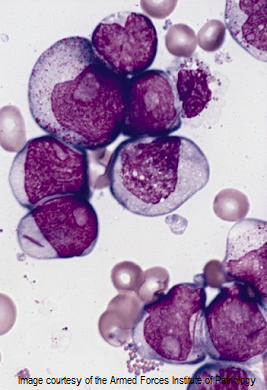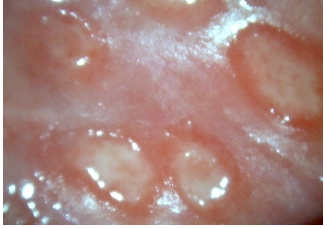Check out today’s Step 2 CK Qmax Question Challenge.
Know the answer? Post it in the comments below! Don’t forget to check back for an update with the correct answer and explanation (we’ll post it in the comments section below).
 A 32-year-old man with trisomy 21 presents with fatigue and swollen, bleeding gums for the past 5 days. He lives in a group home and was formerly employed in a factory manufacturing hair products. He has smoked 1 pack of cigarettes per day for the past 15 years. He denies the use of illicit drugs. Physical examination reveals pallor, diffuse petechiae, oozing oral mucosa, and splenomegaly. Bone marrow aspirate reveals the type of cell shown in the image.
A 32-year-old man with trisomy 21 presents with fatigue and swollen, bleeding gums for the past 5 days. He lives in a group home and was formerly employed in a factory manufacturing hair products. He has smoked 1 pack of cigarettes per day for the past 15 years. He denies the use of illicit drugs. Physical examination reveals pallor, diffuse petechiae, oozing oral mucosa, and splenomegaly. Bone marrow aspirate reveals the type of cell shown in the image.
Which of the following risk factors most likely contributed to the development of this patient’s condition?
A. Age <40 years
B. Down syndrome (trisomy 21)
C. Exposure to Epstein-Barr virus in his home
D. History of alcohol abuse
E. Prior lead exposure
———————–
Want to know the ‘bottom line?’ Purchase a USMLE-Rx Subscription and get many more features, more questions, and passages from First Aid, including images, references, and other facts relevant to this question.
This practice question is an actual question from the USMLE-Rx Step 2 CK test bank. Get more Step 2 CK study help atUSMLE-Rx.com.




B
B
Trisomy 21 it is.
B)
Down’s Syndrome predisposes to AML
Auer Rods seen
M3 AML (B)
The correct answer is B. The bone marrow aspirate reveals the presence of blasts containing Auer rods (see arrow). These red-staining structures are abnormal azurophilic granules that are very numerous in acute myelogenous leukemia (AML). The patient’s presentation is consistent with the manifestations of a leukocytosis (as is found in AML), leading to anemia and thrombocytopenia, as well as splenomegaly. Compared to the general population, patients with Down syndrome are 20 times more likely to develop acute leukemias.
A is not correct. The bone marrow aspirate reveals the presence of blasts containing Auer rods, which is suggestive of acute myeloid leukemia. This disease is associated with advancing age, and >50% of cases occur in persons >60 years of age.
C is not correct. The bone marrow aspirate reveals the presence of blasts containing Auer rods, which is suggestive of acute myeloid leukemia (AML). Although exposure to Epstein-Barr virus has been implicated in the development of some types of lymphoma and carcinoma, there is no known association with AML.
D is not correct. Alcohol abuse can significantly increase the risk of cancers of the oropharynx, liver, breast, and colon. However, this patient most likely has a hematologic malignancy as suggested by the bone marrow aspirate and is most likely not linked to his history of alcohol abuse.
E is not correct. The bone marrow aspirate reveals the presence of blasts containing Auer rods, which is suggestive of acute myeloid leukemia. Exposure to alkylating agents, such as chemotherapeutics, and benzene can increase the risk of development of this disorder. However, there is no known association with lead exposure.
Thank you .
I appreciate the summary! Thank you,
Many thanks for the interesting post, it is very useful information for me.
B. Down Syndrome
Pingback: Anxiety pills for sale
Pingback: pasarqq
Pingback: bonnie mcmurray
Pingback: n?m m? th?y bò c?p
Pingback: n?m m? th?y rùa ?ánh s? m?y
Pingback: | dumps with pin | fresh dumps shop | dumps with pins | buying dumps online | dump pin | dump+pin | dumps and pins | dumps and pin | dumps with pin atm cash out | dumps with pin 2020 | free credit card dumps with pin 2020 | dumps with pin shop | dumps wit
Pingback: ????
Pingback: http://95.111.232.179/
Pingback: kids swimming